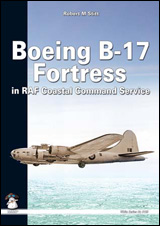The Boeing Flying Fortress in the RAF did not meet the success the British expected and the British use of the B-17 is always overshadowed by the American B-17s. However, even used in small numbers, the Flying Fortress in the RAF made its war during three long years. After a disastrous debut of the B-17C with Bomber Command, the career of the B-17 with the British could have been stopped as early as beginning 1942. But after positive trials of the type with Coastal Command and a desperate need of long range maritime reconnaissance aircraft, the RAF decided to introduce a limited numbers of Flying Fortresses into its front-line squadrons.
Robert Stitt told us in depth this part of the RAF history which has been neglected in the past. In the first 140 pages, the author explains in details what has been the career of the Fortress in the RAF, as maritime reconnaissance aircraft first, then in the Meteorological squadrons. The last 100 pages are dedicated to numerous appendices and this put altogether, we have the feeling to have a good and instructive book in hands illustrated with about 200 photographs.
For sure, this book will find its way on any B-17 Flying Fortress enthusiast’s bookshelves and will seduce anyone interested in the RAF and its aircraft. This book is filling a big gap which was missing for too many years.
Strongly recommended
Phil Listemann
248pages, A4 (21 x 29,7cm), softcover
in English
Le B-17 a une carrière atypique au sein de la RAF ; après des débuts ratés avec le Bomber Command qui lui fera connaître le baptême du feu, la RAF décide de ne plus considérer le B-17 comme un avion devant à tout prix faire partie de son inventaire. Cependant, les besoins d’avions de reconnaissance maritime et le manque d’avions disponibles oblige la RAF à revoir ses plans et le B-17 va finalement connaître une carrière bien remplie au sein du Coastal Command, même si le nombre d’appareils pris en compte va rester marginal tout au long de la guerre.
Robert Stitt nous raconte cette histoire méconnue des « Forteresses Volantes » au sein du Coastal Command, non seulement comme avion de reconnaissance maritime, mais aussi comme avion de reconnaissance météo, tâche ingrate et souvent oubliée, mais ô combien nécessaire à la planification des missions de guerre. Les 248 pages sont divisées en deux parties distinctes, le texte historique d’une part sur 140 pages, illustrées de nombreux témoignages et de près de 200 photos, alors que la deuxième partie propose des annexes aussi nombreuses que variées, ce qui donne au bout du compte un livre complet et plutôt réussi.
Indéniablement, c’est une étude originale qui devrait séduire à la fois les inconditionnels du B-17 et ceux de la RAF.
Philippe Listemann
248 pages, A4 (21 x 29,7 cm), couverture souple
en anglais



